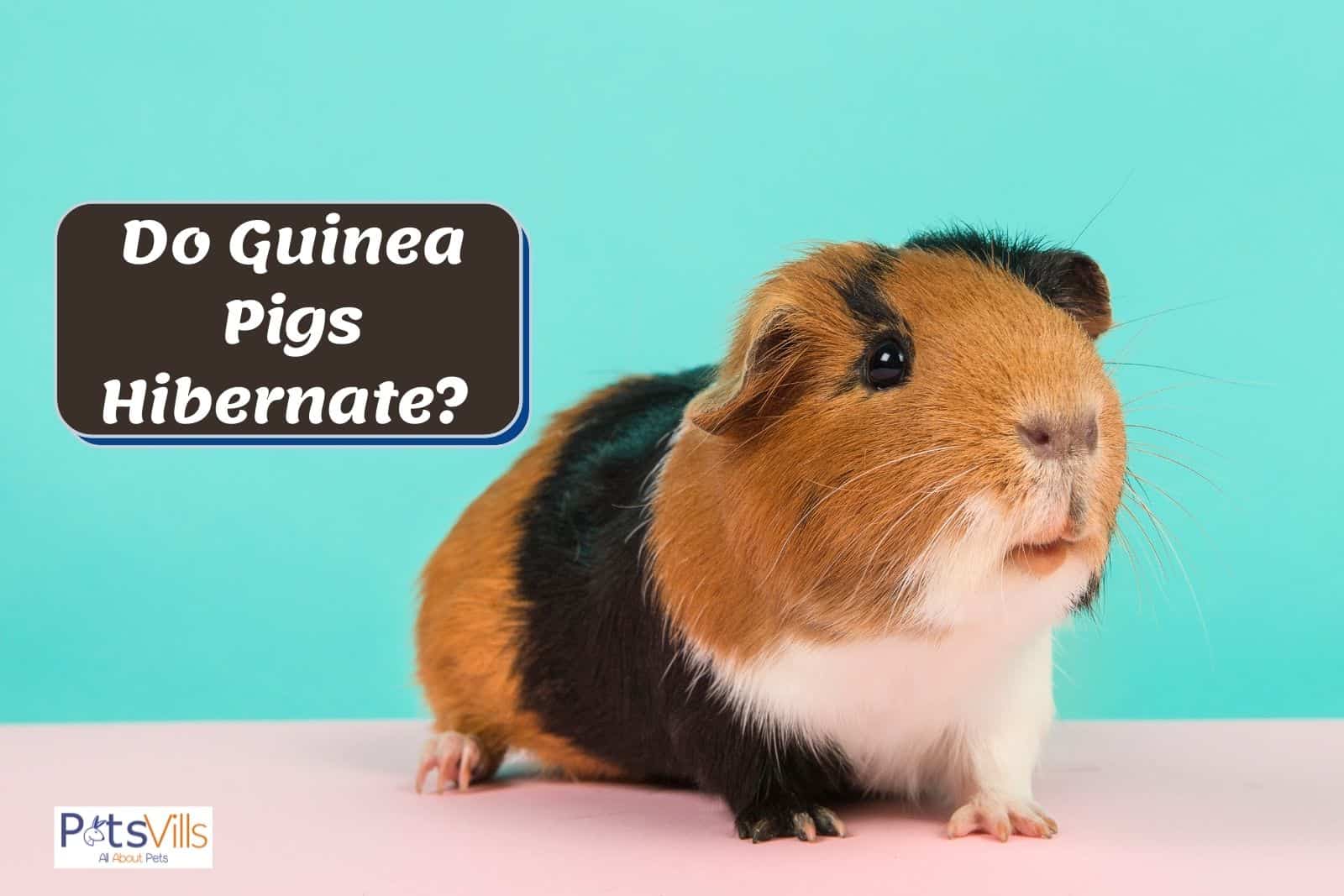If you’re new to owning guinea pigs, you may be wondering if they hibernate like other members of the rodent family.
Do Guinea Pigs Hibernate?
Guinea pigs will not enter a hibernation state even if their living conditions get too cold.
If their outside living condition drops below 15 degrees Celsius (59 Fahrenheit) they will need to be moved to a warmer location.
Table of Contents
Do Guinea Pigs Hibernate?
No, they don’t. In fact, winter is not a natural occurrence to the guinea pig and they will need special care when it gets cold. You may even find that some days in early fall are too cold for guinea pigs.
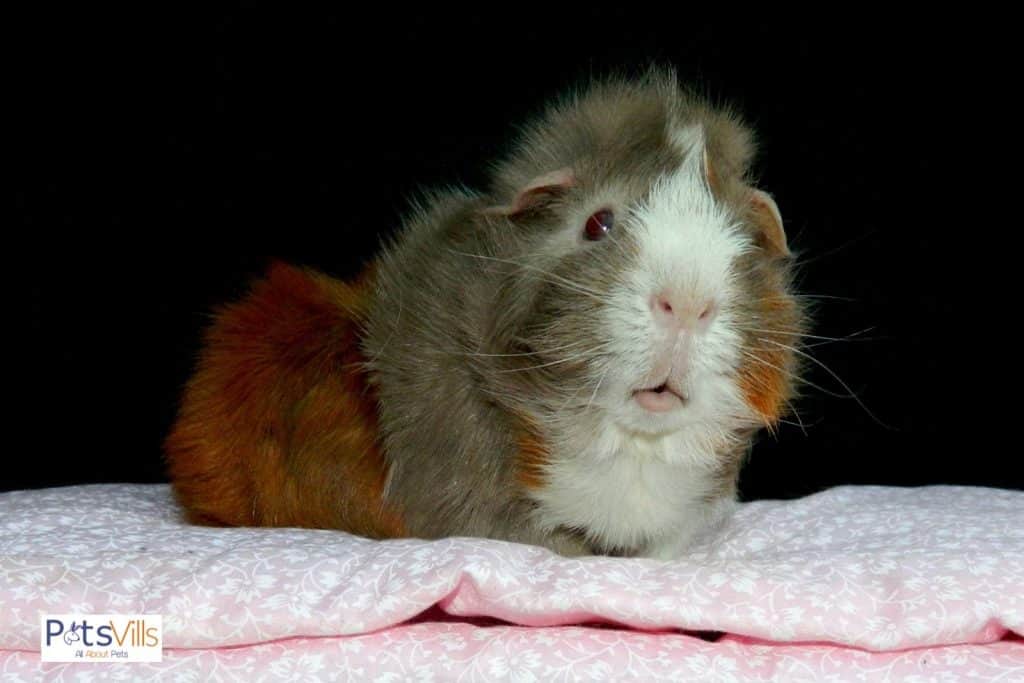
Your pet’s habitat should be kept warm at all times to avoid possible health complications. Guinea pigs do have a history of going into hypothermia in cold temperatures.
If you do find your pet becoming lethargic in cold winter months then take them to the vet immediately. Lethargy is a sure sign of a worse medical condition.
READ MORE: Do Guinea Pigs Recognize Their Owners?
Do Guinea Pigs Do Well in Cold Weather?
Guinea pigs originate from South America, from Peru to be exact. They are therefore used to warm and dry weather, so it is logical that they don’t really do that great in cold weather.
Guinea pigs are most comfortable in temperatures between 65 – 75°F (18-24°C) during the day. During the night, they should be kept in temperatures higher than 60°F (15°C).
The absolute minimum in which guinea pigs can survive is 50°F (10°C) if the air around them is dry. However, if there is condensation around them, they may start to suffer from cold-related issues even at higher temperatures.
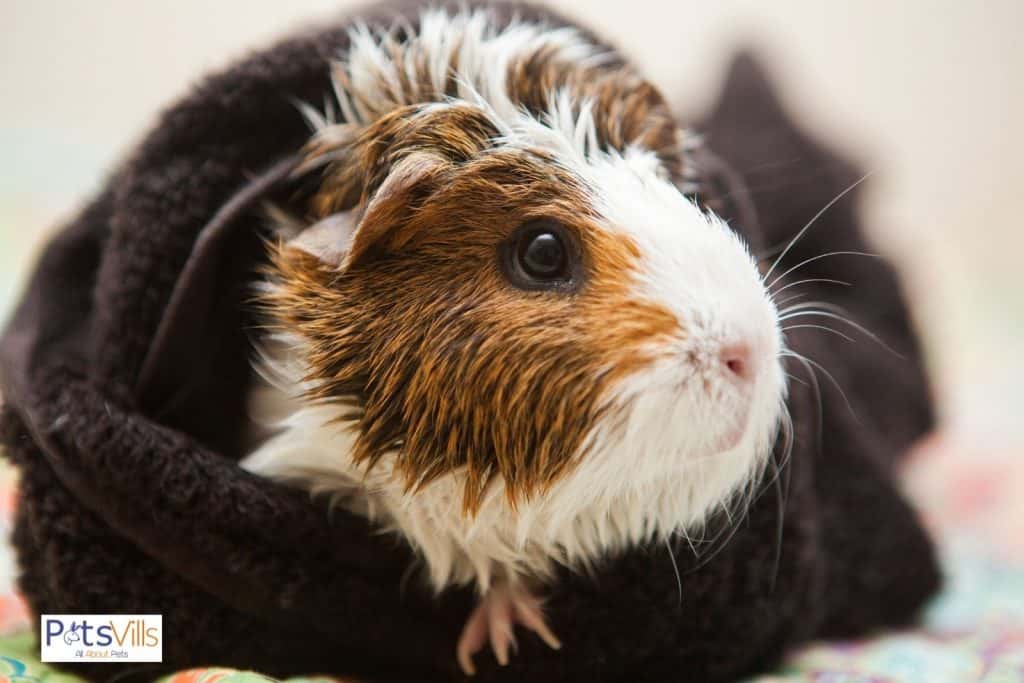
Although guinea pigs don’t hibernate during the winter, they can become less active and sleep a bit more if it’s too cold for them. However, keep in mind that lethargy and inactiveness are signs of a potential problem. If the temperature gets too low for your guinea pig, it may suffer from hypothermia, which can be fatal in many cases.
Hypothermia in Guinea Pigs
Hypothermia is a term for a medical emergency in which your guinea pig starts to lose body heat faster than it can produce it, which leads to dangerously low body temperature.
Mild hypothermia in guinea pigs can kick in when the body heat drops to less than 95°F (35°C). If it continues to drop, it quickly becomes a life-threatening condition.
Of course, ill guinea pigs and older ones are more likely to suffer from hypothermia and other cold-related problems.
Hypothermia is also likely to happen faster if the guinea pig is ill or old, leaving even less time for your reaction and treatment of hypothermia.
Symptoms of Hypothermia
There are a couple of signs to look for when your guinea pigs suffer from hypothermia. Most of the time it will go unnoticed until it’s too late.
1. Lack of Appetite
This will be the most common symptom of hypothermia. The guinea pigs will stay in a single location for a very long time and not eat anything, even if you put it right in front of them.
2. Look for Their Daily Activities
If your guinea pig is usually active, but now they are staying in a single location for a very long time, it could mean they are suffering from hypothermia.
By staying in a single location for a long time, they are conserving their energy and keeping themselves warm.
3. Quick and Shallow Breathing
By breathing this way, it lowers their heart rate which will slow the blood flow.
Above are just the symptoms of hypothermia that are common in guinea pigs. There are other symptoms as well and if you’re unsure, it’s best to seek medical attention right away.
What to do About it?
If you notice any of these symptoms, you need to get your guinea pig warm. If it is living outside, bring it inside and try to warm it up. However, try not to do it too quickly.
Place your guinea pig on dry bedding, preferably veterinary fleece bedding. If you don’t have it, a blanket or a towel will have to do. Try to insulate your pet by putting the bedding over its body to increase its body heat.
You can use an additional source of heat, like a heating pad, but remember to turn the guinea pig over every 15 minutes or so, especially if your furry friend is not moving on its own.
If your guinea pig is not responding to the immediate treatment, call your vet for advice on any additional steps you may take to help your pet survive hypothermia.
How to Care for Your Guinea Pig in the Winter
So, now we know that guinea pigs are not well-suited for living in cold weather.
With that in mind, you need to make sure that your guinea pig has the best living conditions in order to make it comfortable during the winter and to avoid potential cold-related problems, like hypothermia.
That means that you need to find the best location for your guinea pig’s hutch or cage, provide the proper insulation to keep your guinea pig warm, and do other things that can help your guinea pig stay comfortable during the cold winter months.
Should You Keep Your Guinea Pig Outdoors?
If it is possible, you should keep your guinea pig indoors in the winter.
Keeping them outdoors is a risk you don’t want to take unless you absolutely can’t find space for your pet’s cage or hutch in your home. In this case, you should at least put the hutch in a shed or garage if you have them.
However, if none of this is possible, you can still keep your furry friend warm in the winter if you take the right steps.
First of all, you need to find a place for your guinea pig’s hutch where it will be protected from the elements like wind, rain, and snow.
If you don’t have a shed or garage to keep the hutch in, a well-protected porch can do the trick.
READ MORE ABOUT Guinea Pigs Life Expectancy
How to Keep Your Guinea Pig Warm in an Outdoor Hutch?
If your guinea pig is spending the winter in an outdoor hutch, it is very important to make sure that the hutch is winter-ready.
That means that it should be well-insulated and able to protect your guinea pig from the elements and predators.
Start by raising the hutch off the ground if you haven’t done it already. You can do it by simply adding legs to the hutch or at least putting the hutch on some bricks to raise the height.
This is important because the bottom of the hutch can rot if it becomes wet, which is a realistic possibility in the winter.
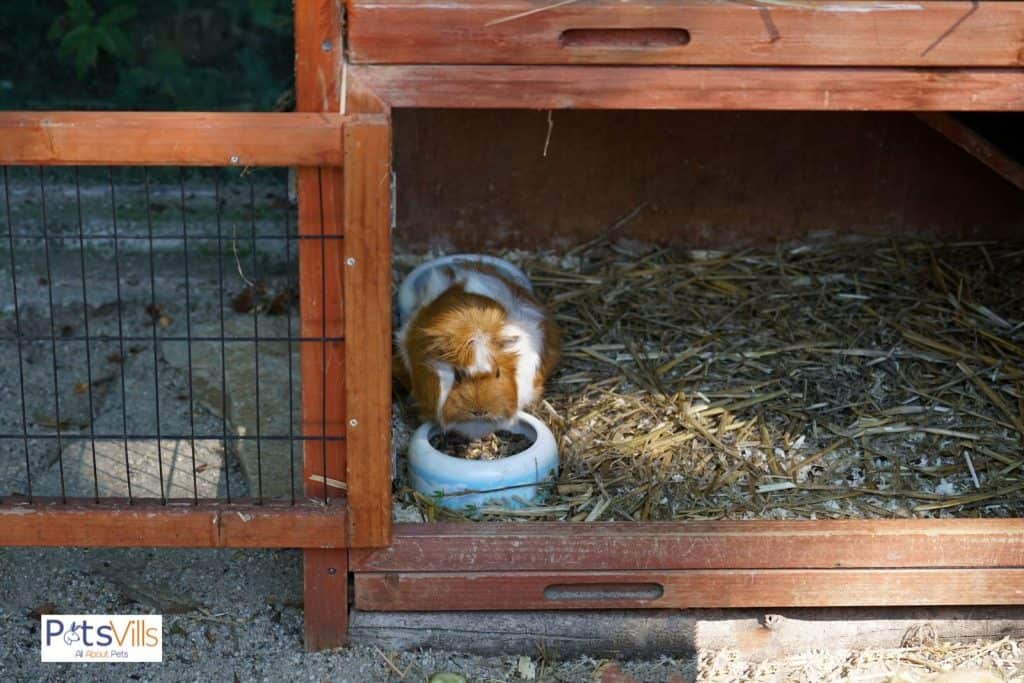
The next thing to pay attention to is the roof of the hutch. It should be covered with roofing felt to protect the hutch from the elements and many hutches come with roofs made of poor materials.
If that is the case, you should consider changing the roof. Choose a slopping roof instead of a flat one because they are likely to last longer in bad weather conditions.
1. Insulate the Hutch
The first thing you have to do is to make sure that your guinea pig’s hutch is well-insulated and covered. This will keep the hutch protected from rain and snow and help maintain a warmer temperature.
You can use a thick blanket to cover the hutch, but you should drape some tarpaulin over the blanket to preserve heat in the hutch.
When you cover the hutch, you need to make sure to leave a small gap for ventilation during the night. During the day, you can take half of the blanket off, especially if it’s not that cold outside.
Another thing you can use, which is probably more effective anyway, is Scratch and Newton Chartwell Double Hutch Hugger.
There are numerous “hutch huggers”, “hutch snuggles” and other hutch covers on the market, so find the brand you think is best for your hutch.
This particular one is made out of special material used by NASA on space shuttles and it has a specific purpose of regulating the temperature in your guinea pig’s hutch.
This cover can be used in the summer as well since it can keep the hutch cool, just as it keeps it warm during the winter.
To protect the hutch from winds and draught, you can turn the front to face the wall of your house in order to prevent draught and rain from getting into the hutch.
Another option is to cover the mesh wire on the front side with Perspex.
2. Use Extra Bedding
While this may sound obvious, it is worth mentioning since many owners seem to forget the importance of bedding in keeping your pet dry and warm in the winter.
First of all, you should put a lot of shredded paper and hay in the hutch so your guinea pig can crawl under it and preserve its body heat.
Your guinea pig can also nibble on the hay and get extra calories to help it stay warm.
In addition to this, you can also put a shoebox or any other small box and cut a hole in it so your guinea pig can go inside.
Of course, you should stuff some type of bedding into the shoe box as well. This can provide additional protection from the cold for your furry friend.
You can also put a small blanket or some old piece of clothing in the hutch to provide even more insulation for your guinea pig.
3. Use a Heating Pad
A heating pad can be a quick, effective way to provide your guinea pig with extra heat and keep it warm.
There are many brands you can choose from but our favorite is the Snugglesafe Heat Pad. This pad comes covered with fleece to make it more comfortable for your pet.
It is made of hard plastic so it can’t be chewed and all you have to do before you use it is put it in the microwave for a few minutes and it will stay warm for a few hours.
If you don’t have a heating pad, you can also use a rice sock as an alternative. Just take an old sock and fill it with rice and then put it in your microwave for one minute.
This will heat the rice enough to make it warm and comfortable for your guinea pig to snuggle with.
Additional Tips to Keep Your Guinea Pig Warm in the Winter
- Check the water bottle regularly – In cold temperatures, the water bottle can easily freeze. Press the little ball a few times a day to keep it moving. You can also get special bottle covers to prevent freezing. However, you should still check the bottle on a daily basis.
- Keep guinea pigs together – If you have more than one guinea pig, keep them together. That way, they will snuggle and keep each other warm. In addition to this, guinea pigs are social animals and need company.
- Buy a cozy or a cuddle cup – Guinea pigs love to snuggle up inside a cozy or a cuddle cup and this can help them preserve their body heat.
- Create tunnels in the hutch – You can make or buy tunnels for your guinea pigs to run in them and stay inside to rest or sleep.
- Get them indoors – If you have space in your home, you should consider setting up a cage for the winter. Your guinea pigs will appreciate it and you will not have to do as much work to keep your guinea pigs warm.
READ MORE: Can Guinea Pigs Live Alone?
FAQs
Are Guinea Pigs Comfortable in Hot Weather?
Guinea pigs are most comfortable in temperatures between 65-75°F (18-24°C). High temperatures can lead to heatstroke in guinea pigs. In fact, temperatures above 80°F (27°C) are too high for guinea pigs.
What Is a Normal Body Temperature for Guinea Pigs?
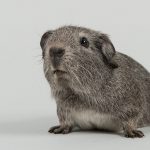
Guinea pigs have a normal body temperature of 98-10°F (37-39°C). If your guinea pig has a body temperature above 104°F (40°C), this is a sign that it may be suffering from a heat stroke.
How to Prevent Heat Stroke in Guinea Pigs?
In the summer, it is vital to keep your pet cool to avoid heatstroke. Don’t expose your guinea pig to the sun, provide plenty of drinking water for your guinea pig and keep the temperature in your home between 65-75°F (18-24°C) if your guinea pig lives indoors.

Did you ever face hypothermia with your guinea pigs? Let us know in the comments how fast it’s recovered!
Alina Hartley is a small-town girl with a ginormous love of bearded dragons. It all started with Winchester, a baby bearded who was abandoned at the shelter by his former owners because of a birth defect that caused one front leg to be shorter than the other. Alina originally went to the shelter looking for a guinea pig, but one look at Winchester and it was love at first sight. From that day on, Alina has dedicated her life to learning everything she can about bearded dragons. She loves helping new beardie parents start their incredible journey with these magnificent reptiles.
Follow her on:
LINKEDIN
TWITTER.
Read her latest articles HERE
Learn more about her HERE.

